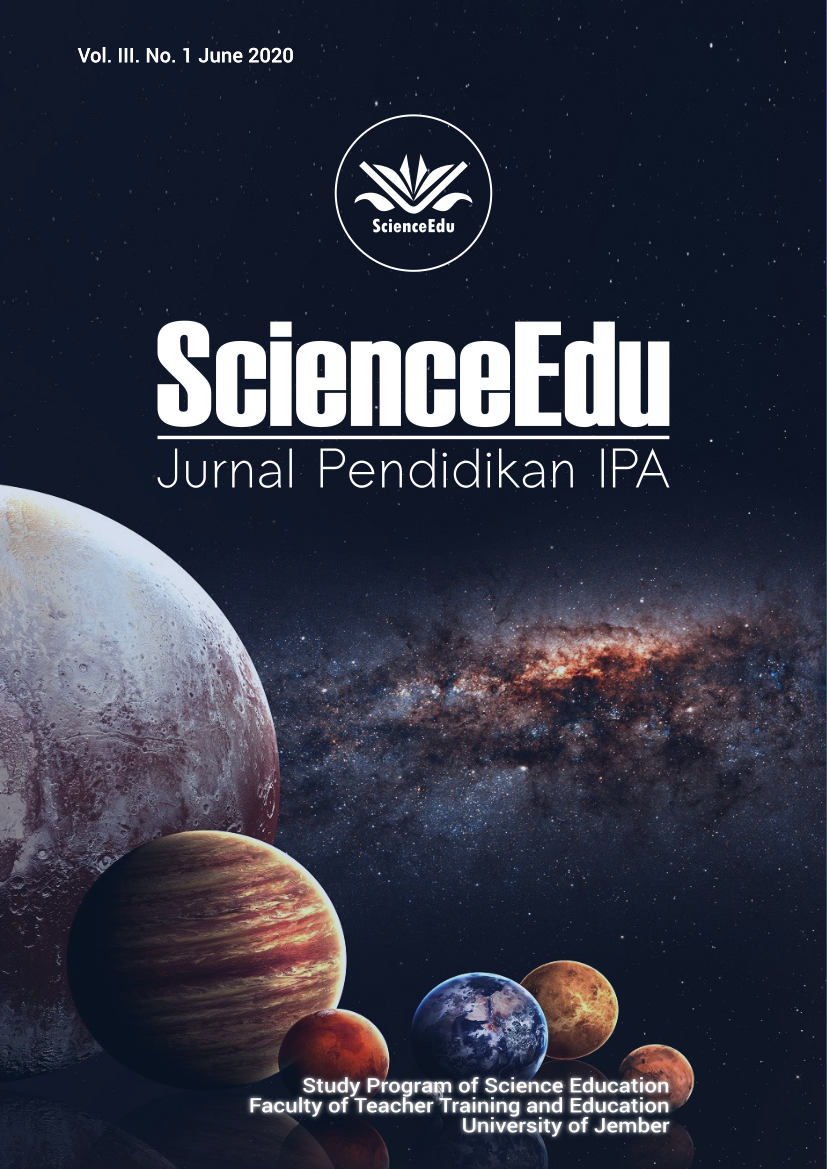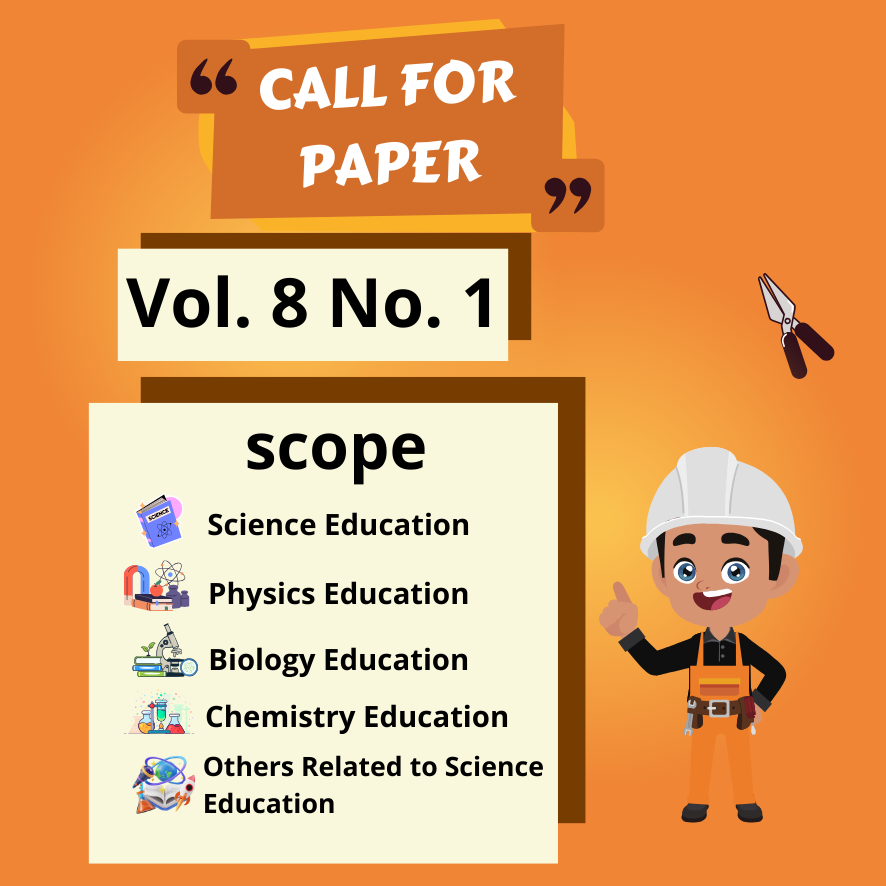LEARNING OF SCIENCE WITH INQUIRY LEARNING MODELS WITH PICTORIAL RIDDLE THE RELATIONSHIP WITH THE CRITICAL THINKING SKILLS OF SMP STUDENTS
DOI:
https://doi.org/10.19184/se.v3i1.17490Keywords:
Pictorial riddle, Critical thinking skills, Pre-test post-test control group designAbstract
The inquiry learning model is a learning model that encourages student activity in learning activities. This inquiry learning model is accompanied by one of the learning media namely pictorial riddle in the form of puzzle images. This study aims to examine the effect of science learning with inquiry learning models accompanied by pictorial riddle relation to critical thinking skills of junior high school students. This type of research is an experiment using a pre-test post-test control group design. The study population was Grade VII students of SMP Negeri 1 Ambulu, sampling using a homogeneity test. The data analysis technique uses Independent samples t-test. The results of the Kolmogorov Smirnov normality test showed that both samples were normally distributed, so the hypothesis test uses a parametric statistical test called the Independent Sample T-test. Based on the results of the Independent Sample T-test, there is a significant influence on the results of critical thinking skills.
Downloads
References
Arikunto, S. 2003. Research Procedure A Practice Approach. Jakarta: Bina Aksara
Arviansyah, R. Indrawati, & Alex, H. 2016. The Effect of Guided Inquiry Learning Model Accompanied by Audiovisual Worksheet on Student Activities and Learning Outcomes in Middle School. Journal of Physics Learning. Vol 4 (4): 308-314
As'ari, R. 2018. Community Knowledge and Attitude in Preserving the Environment's Relationship with the Behavior of Maintaining Sustainability of the Ten Thousand Hills Area in Tasikmalaya City. GeoEco Journal. Vol 4 (1): 9-18
Budiastra, AK, Erlina, N., & Wicaksono, I. 2019. The Factors Affecting Teachers' Readiness in Developing Science Concept Assessment Through Inquiry-Based Learning Process In Elementary Schools. Advances in the Social Sciences Research Journal. vol 6 (9): 355-366
Hanifah, N. 2016. Differences in Learning Outcomes of Material Elasticity Through the Cooperative Learning Model Type Jigsaw and Student Archive Divison (STAD) Class X Students of SMA Negeri 5 Banda Aceh. Scientific Journal of Physical Education Students. Vol 1 (3): 67-73
Israwani. 2015. Use of Inquiry Learning Model in Numbers Count Operations Material in Class I SD Negeri 53 Banda Aceh. Opportunity Journal. Vol 3 (2): 55-64
Jatmiko, B., Binar, KP, Munasir., ZAIS, Iwan, W., Nia., Paken, P., Rosyid, A., and Zainuddin. 2018. The Comparison Of OR-IPA Teaching Models and Problem Based Learning Models Effectiveness to Improve Critical Thinking Skills of Pre-Service Physics Teachers. Journal of Baltic Science Education. Vol 17 (2): 300-319
Kurniawati, ID, Wartono., & MD 2014. The Effect of Guided Inquiry Learning The Integration of Peer Instruction Against Mastery of Concepts and Students' Critical Thinking Ability. Indonesian Journal of Physical Education. Vol 10: 36-46
Luftiati, E., & Woro, S. 2017. Application of a Pictorial Riddle Inquiry Based Student Book on Momentum and Impulse Material to Practice Self Regulated Thinking Skills. Journal of Physics Education Innovation. Vol 6 (3): 139-143
M. Putri, Y., Suratno, & Iis, NA 2015. The Effect of Guided Inquiry Learning Models Using Experimental Methods on the Activities and Learning Outcomes of Science-Biology of Class VIII Students of SMP Negeri 2 Maesan Bondowoso. Aura. Vol 4 (2): 163-172
Neolaka, A. 2019. Critical Issues of Primary Education and Remain Important Yet Ignored. Jakarta: Kencana
Rahmawati, I., Arif, H., & Sri, R. 2016. Analysis of Critical Thinking Skills of Middle School Students on Style Materials and Their Application. Proceedings of the National Science Education Postgraduate Semnas UM. Vol 1: 1112-1119
Purwanto, J., & Binti, UH 2014. The Effectiveness of Pictorial Riddle Type Inquiry Learning Model with Integration-Interconnection Content on Temperature and Heat Material on Critical Thinking Ability of High School Students. Kaunia Journal. Vol 10 (2): 117-127
Rangkuti, MA 2018. The Effect of a Pictorial Riddle-Based Inquiry Learning Model on Student Learning Outcomes and Learning Activities. Journal of Physics Learning Innovation. Vol 6 (2): 27-32
Rangkuti, MA, & Ridwan, AS 2018. Analysis of the Critical Thinking Ability of Solving Physics Problems in Learning with Inquiry Learning Models. Inpafi Journal. Vol 6 (3): 10-18
Suhada, H. 2017. Inquiry Learning Model and Ability of Class V Students in Natural Sciences. Journal of Basic Education. Vol 8 (2): 13-24
Sulthon. 2016. Effective and Enjoyable Science Learning for Madrasah Ibtidaiyah (MI) Students. Elementary Vol 4 (1): 38-54
Susilawati, Fihrin, & I wayan, D. 2013. Comparison of Physics Learning Results Between the Pictorial Riddle Method and the Demonstration Method in Guided Inquiry Learning in Class VIII Students of SMP NEGERI 19 PALU. Journal of Physics Education Tadulako (JPF). Vol 1 (3): 8-12. ISSN 2338 3240
Surtriyanti, E., Regina, LP, & Ali, S. 2017. Effect of Pictorial Riddle Learning Methods on Critical Thinking Skills of Elementary Students on Environmental Preservation Materials. Journal of Scientific Pens. Vol 2 (1): 331-340
Susilo. AB 2012. Development of Problem Based Science Learning Model to Improve Learning Motivation and Critical Thinking of Middle School Students. JPE. Vol 1 (1): 57-63
Wahyuni, E., Zulhelmi, and Zuhdi, M. 2018. Application of Cooperative Learning Models Think Talk Write Type To Improve Students' Formal Thinking Ability in Science Learning in Class VIII MTs N 1 Rokan Hulu Filial North Tambusai. JOM FKIP. Vol 5 (1): 1-13
Yusmiono, BA 2018. Visual Learning Media Against Student Learning Outcomes of Geography Education Study Programs at PGRI University Palembang. Factors of Educational Scientific Journal. Vol 5 (1): 1-8
Yusuf, AM 2014. Research Methods: Quantitative, Qualitative, and Combined Research. Jakarta: Kencana



